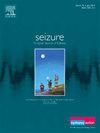在儿童癫痫患者中使用溴伐巴坦:一项回顾性多中心研究。
IF 2.7
3区 医学
Q2 CLINICAL NEUROLOGY
引用次数: 0
摘要
目的:这项回顾性多中心研究旨在评估溴伐他西泮 (BRV) 治疗小儿癫痫的疗效和安全性:我们的队列由 93 名儿童组成(平均年龄为 11.5 ± 7.5 岁),他们患有各种类型的小儿癫痫,包括癫痫性脑病和全身性癫痫。其中,61 名儿童(60.4%)被诊断为局灶性癫痫,19 名儿童(15.8%)被诊断为全身性癫痫,16 名儿童(15.8%)被诊断为合并癫痫,8 名儿童(7.9%)癫痫类型不明。队列中包括罕见的癫痫综合征:8名患者患有伦诺克斯-加斯陶特综合征,3名患者患有德拉沃综合征,1名患者患有拉斯穆森综合征。患者有各种抗癫痫药物(ASMs)病史(6.42 ± 3.15),在部署 BRV 时平均正在接受两种以上(2.57 ± 1.16)药物的治疗:保留率很高,80.6%的患者在 3 个月后坚持治疗,66.7%的患者在 6 个月后坚持治疗,45.2%的患者在 12 个月后坚持治疗。29名患者(30.1%)在一夜之间从左乙拉西坦(LEV)转为使用BRV,结果5名患者(17.2%)的行为不良反应(AEs)有所减少。3个月时的应答率为25.8%,6个月时为16.1%,12个月时为17.2%,癫痫性脑病组无应答者。治疗耐受性良好,70 名患者(75.3%)未报告任何不良反应。10名患者(10.7%)出现了短暂的不良反应,13名患者(14.0%)因不良反应而需要调整剂量或停用BRV:结论:约五分之一的耐药性癫痫儿童患者对BRV有反应,局灶性癫痫发作患者的反应最好。但对癫痫性脑病患者的影响有限。本文章由计算机程序翻译,如有差异,请以英文原文为准。
Brivaracetam use in children with epilepsy: A retrospective multicenter study
Purpose
This retrospective multicenter study aimed to assess the efficacy and safety of brivaracetam (BRV) in pediatric epilepsy.
Methods
Our cohort consisted of 93 children (mean age 11.5 ± 7.5 years) with a wide spectrum of pediatric epilepsy, including epileptic encephalopathy and generalized epilepsy. Of these, 61 (60.4%) were diagnosed with focal epilepsy, 19 (15.8%) with generalized epilepsy, and 16 (15.8%) with combined epilepsy, while 8 patients (7.9%) had an unknown epilepsy type. The cohort included rare epilepsy syndromes: 8 patients with Lennox-Gastaut syndrome, 3 with Dravet syndrome, and 1 with Rasmussen syndrome. Patients had a history of various antiseizure medications (ASMs) (6.42 ± 3.15), and on average, were being treated with more than two (2.57 ± 1.16) drugs at the time of BRV deployment.
Results
Retention rates were high, with 80.6% of patients adhering to treatment at 3 months, 66.7% at 6 months, and 45.2% at 12 months. In 29 patients (30.1%), BRV was added in an overnight switch from levetiracetam (LEV), resulting in a reduction of behavioral adverse effects (AEs) in 5 patients (17.2%). The response rate was 25.8% at 3 months, 16.1% at 6 months, and 17.2% at 12 months, with no responders in the epileptic encephalopathy group. Therapy tolerance was notable, with 70 patients (75.3%) reporting no AEs. Transient AEs occurred in 10 patients (10.7%), and in 13 cases (14.0%), the AEs warranted dose adjustment or discontinuation of BRV.
Conclusion
Approximately one-fifth of pediatric patients with drug-resistant epilepsy responded to BRV, with the best response observed in patients with focal seizures. However, the impact on patients with epileptic encephalopathy was limited.
求助全文
通过发布文献求助,成功后即可免费获取论文全文。
去求助
来源期刊

Seizure-European Journal of Epilepsy
医学-临床神经学
CiteScore
5.60
自引率
6.70%
发文量
231
审稿时长
34 days
期刊介绍:
Seizure - European Journal of Epilepsy is an international journal owned by Epilepsy Action (the largest member led epilepsy organisation in the UK). It provides a forum for papers on all topics related to epilepsy and seizure disorders.
 求助内容:
求助内容: 应助结果提醒方式:
应助结果提醒方式:


